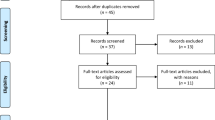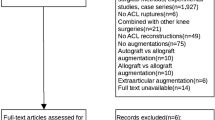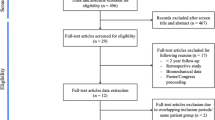Abstract
Purpose
The objective of this study was to systematically review the current evidence to see whether the remnant preservation techniques could obtain better clinical outcomes than the standard anterior cruciate ligament reconstruction procedure.
Methods
The authors systematically searched online databases to identify the studies which compared the remnant preservation techniques with the standard techniques. Two reviewers independently extracted data and evaluated the methodological quality of each study. Clinical outcomes in terms of knee stability, clinical scores, vascularization, proprioception, tibial tunnel enlargement and complications were qualitatively compared.
Results
Thirteen studies met the inclusion criteria for review. Compared with the standard procedure, significantly better results regarding knee stability in the remnant preserving group were reported in two of nine studies in the instrumented knee laxity, one of eight studies in the Lachman test and none of eight studies regarding the pivot shift test. Five studies assessed International Knee Documentation Committee scores but found no differences. One of two studies indicated significantly earlier revascularization according to the signal/noise quotient value of the graft on magnetic resonance imaging. One of two studies indicated significantly better proprioceptive function in terms of joint position sense using the reproduction of passive positioning test. Two of two studies showed significantly less tibial tunnel enlargement in the remnant preserving group. None of the studies showed significant increase in the risk of cyclops lesion formation and the loss of knee range of motion in the remnant augmentation group.
Conclusions
The current evidence suggests that the short-term clinical outcomes of patients with the remnant augmentation technique are comparable, if not superior, with that of patients undergoing the standard technique, although it is insufficient to justify the remnant preserving augmentation as a routine treatment for anterior cruciate ligament ruptures.
Level of evidence
Systematic review, Level IV.

Similar content being viewed by others
References
Adachi N, Ochi M, Uchio Y, Iwasa J, Ryoke K, Kuriwaka M (2002) Mechanoreceptors in the anterior cruciate ligament contribute to the joint position sense. Acta Orthop Scand 73:330–334
Adachi N, Ochi M, Uchio Y, Sumen Y (2000) Anterior cruciate ligament augmentation under arthroscopy. A minimum 2-year follow-up in 40 patients. Arch Orthop Trauma Surg 120:128–133
Ahn JH, Lee SH, Choi SH, Lim TK (2010) Magnetic resonance imaging evaluation of anterior cruciate ligament reconstruction using quadrupled hamstring tendon autografts: comparison of remnant bundle preservation and standard technique. Am J Sports Med 38:1768–1777
Ahn JH, Wang JH, Lee YS, Kim JG, Kang JH, Koh KH (2011) Anterior cruciate ligament reconstruction using remnant preservation and a femoral tensioning technique: clinical and magnetic resonance imaging results. Arthroscopy 27:1079–1089
Arnoczky SP (1983) Anatomy of the anterior cruciate ligament. Clin Orthop Relat Res 172:19–25
Bali K, Dhillon MS, Vasistha RK, Kakkar N, Chana R, Prabhakar S (2012) Efficacy of immunohistological methods in detecting functionally viable mechanoreceptors in the remnant stumps of injured anterior cruciate ligaments and its clinical importance. Knee Surg Sports Traumatol Arthrosc 20:75–80
Barrett DS, Cobb AG, Bentley G (1991) Joint proprioception in normal, osteoarthritic and replaced knees. J Bone Joint Surg Br 73:53–56
Borbon CA, Mouzopoulos G, Siebold R (2012) Why perform an ACL augmentation? Knee Surg Sports Traumatol Arthrosc 20:245–251
Cha J, Choi SH, Kwon JW, Lee SH, Ahn JH (2012) Analysis of cyclops lesions after different anterior cruciate ligament reconstructions: a comparison of the single-bundle and remnant bundle preservation techniques. Skeletal Radiol 41:997–1002
Coleman BD, Khan KM, Maffulli N, Cook JL, Wark JD (2000) Studies of surgical outcome after patellar tendinopathy: clinical significance of methodological deficiencies and guidelines for future studies. Victorian Institute of Sport Tendon Study Group. Scand J Med Sci Sports 10:2–11
Demirag B, Ermutlu C, Aydemir F, Durak K (2012) A comparison of clinical outcome of augmentation and standard reconstruction techniques for partial anterior cruciate ligament tears. Eklem Hastalik Cerrahisi 23:140–144
Espregueira-Mendes J, Pereira H, Sevivas N, Passos C, Vasconcelos JC, Monteiro A et al (2012) Assessment of rotatory laxity in anterior cruciate ligament-deficient knees using magnetic resonance imaging with Porto-knee testing device. Knee Surg Sports Traumatol Arthrosc 20:671–678
Fu FH, Bennett CH, Ma CB, Menetrey J, Lattermann C (2000) Current trends in anterior cruciate ligament reconstruction. Part II. Operative procedures and clinical correlations. Am J Sports Med 28:124–130
Georgoulis AD, Pappa L, Moebius U, Malamou-Mitsi V, Pappa S, Papageorgiou CO et al (2001) The presence of proprioceptive mechanoreceptors in the remnants of the ruptured ACL as a possible source of re-innervation of the ACL autograft. Knee Surg Sports Traumatol Arthrosc 9:364–368
Gohil S, Annear PO, Breidahl W (2007) Anterior cruciate ligament reconstruction using autologous double hamstrings: a comparison of standard versus minimal debridement techniques using MRI to assess revascularisation. A randomised prospective study with a one-year follow-up. J Bone Joint Surg Br 89:1165–1171
Hong L, Li X, Zhang H, Liu X, Zhang J, Shen JW et al (2012) Anterior cruciate ligament reconstruction with remnant preservation: a prospective, randomized controlled study. Am J Sports Med 40:2747–2755
Jung YB, Jung HJ, Siti HT, Lee YS, Lee HJ, Lee SH et al (2011) Comparison of anterior cruciate ligament reconstruction with preservation only versus remnant tensioning technique. Arthroscopy 27:1252–1258
Junkin DM Jr, Johnson DL (2008) ACL tibial remnant, to save or not? Orthopedics 31:154–159
Kazusa H, Nakamae A, Ochi M (2013) Augmentation technique for anterior cruciate ligament injury. Clin Sports Med 32:127–140
Lee BI, Kwon SW, Kim JB, Choi HS, Min KD (2008) Comparison of clinical results according to amount of preserved remnant in arthroscopic anterior cruciate ligament reconstruction using quadrupled hamstring graft. Arthroscopy 24:560–568
Lee BI, Min KD, Choi HS, Kwon SW, Chun DI, Yun ES et al (2009) Immunohistochemical study of mechanoreceptors in the tibial remnant of the ruptured anterior cruciate ligament in human knees. Knee Surg Sports Traumatol Arthrosc 17:1095–1101
Maestro A, Suarez–Suarez MA, Rodriguez-Lopez L, Villa-Vigil A (2013) Stability evaluation after isolated reconstruction of anteromedial or posterolateral bundle in symptomatic partial tears of anterior cruciate ligament. Eur J Orthop Surg Traumatol 23:471–480
Muneta T, Koga H, Ju YJ, Horie M, Nakamura T, Sekiya I (2013) Remnant volume of anterior cruciate ligament correlates preoperative patients’ status and postoperative outcome. Knee Surg Sports Traumatol Arthrosc 21:906–913
Muramatsu K, Hachiya Y, Izawa H (2008) Serial evaluation of human anterior cruciate ligament grafts by contrast-enhanced magnetic resonance imaging: comparison of allografts and autografts. Arthroscopy 24:1038–1044
Nakase J, Toratani T, Kosaka M, Ohashi Y, Tsuchiya H (2013) Roles of ACL remnants in knee stability. Knee Surg Sports Traumatol Arthrosc 21:2101–2106
Naylor AJ, Mohtadi NGH, Chan DS, Humphrey RS, Donald M (2013) Anterior cruciate ligament preservation during reconstructive surgery: does the extra surgical effort improve patient outcomes at one year? Sport Orthop Traumatol 29:29–39
Ochi M, Adachi N, Uchio Y, Deie M, Kumahashi N, Ishikawa M et al (2009) A minimum 2-year follow-up after selective anteromedial or posterolateral bundle anterior cruciate ligament reconstruction. Arthroscopy 25:117–122
Papalia R, Franceschi F, Vasta S, Di Martino A, Maffulli N, Denaro V (2012) Sparing the anterior cruciate ligament remnant: is it worth the hassle? Br Med Bull 104:91–111
Papalia R, Franceschi F, Zampogna B, Tecame A, Maffulli N, Denaro V (2012) Surgical management of partial tears of the anterior cruciate ligament. Knee Surg Sports Traumatol Arthrosc. doi:10.1007/s00167-012-2339-1
Park SY, Oh H, Park SW, Lee JH, Lee SH, Yoon KH (2012) Clinical outcomes of remnant-preserving augmentation versus double-bundle reconstruction in the anterior cruciate ligament reconstruction. Arthroscopy 28:1833–1841
Pujol N, Colombet P, Potel JF, Cucurulo T, Graveleau N, Hulet C et al (2012) Anterior cruciate ligament reconstruction in partial tear: selective anteromedial bundle reconstruction conserving the posterolateral remnant versus single-bundle anatomic ACL reconstruction: preliminary 1-year results of a prospective randomized study. Orthop Traumatol Surg Res 98:S171–S177
Qi J, Chen J, Chen S, Li Y, Hua Y, Li H et al (2010) Prospective study on anterior cruciate ligament reconstruction with preserving remnant anterior cruciate ligament by allograft ligament. Zhongguo Xiu Fu Chong Jian Wai Ke Za Zhi 24:917–921
Sanchis-Alfonso V, Zaffagnini S, Roselló-Sastre E, Carda C, Monteagudo C (2013) Graft healing in ACL reconstruction: can we enhance it in clinical practice? In: Sanchis-Alfonso V, Monllau JC (eds) The ACL-deficient knee. Springer, London, pp 113–129
Schutte MJ, Dabezies EJ, Zimny ML, Happel LT (1987) Neural anatomy of the human anterior cruciate ligament. J Bone Joint Surg Am 69:243–247
Siebold R, Fu FH (2008) Assessment and augmentation of symptomatic anteromedial or posterolateral bundle tears of the anterior cruciate ligament. Arthroscopy 24:1289–1298
Song GY, Zhang H, Zhang J, Li X, Chen XZ, Li Y et al (2013) The anterior cruciate ligament remnant: to leave it or not? Arthroscopy 29:1253–1262
Suomalainen P, Jarvela T, Paakkala A, Kannus P, Jarvinen M (2012) Double-bundle versus single-bundle anterior cruciate ligament reconstruction: a prospective randomized study with 5-year results. Am J Sports Med 40:1511–1518
Van Dyck P, De Smet E, Veryser J, Lambrecht V, Gielen JL, Vanhoenacker FM et al (2012) Partial tear of the anterior cruciate ligament of the knee: injury patterns on MR imaging. Knee Surg Sports Traumatol Arthrosc 20:256–261
Wilson TC, Kantaras A, Atay A, Johnson DL (2004) Tunnel enlargement after anterior cruciate ligament surgery. Am J Sports Med 32:543–549
Yasuda K, Kondo E, Kitamura N, Kawaguchi Y, Kai S, Tanabe Y (2012) A pilot study of anatomic double-bundle anterior cruciate ligament reconstruction with ligament remnant tissue preservation. Arthroscopy 28:343–353
Yoon KH, Bae DK, Cho SM, Park SY, Lee JH (2009) Standard anterior cruciate ligament reconstruction versus isolated single-bundle augmentation with hamstring autograft. Arthroscopy 25:1265–1274
Zhang Q, Zhang S, Cao X, Liu L, Liu Y, Li R (2012) The effect of remnant preservation on tibial tunnel enlargement in ACL reconstruction with hamstring autograft: a prospective randomized controlled trial. Knee Surg Sports Traumatol Arthrosc. doi:10.1007/s00167-012-2341-7
Acknowledgments
This work was supported by The National Natural Science Foundation of China (No. 81171699). The authors thank Ramona L. Kirk and Hugo Giambini (Mayo Clinic) for English editing.
Conflict of interest
The authors declare that they have no conflicts of interest.
Author information
Authors and Affiliations
Corresponding author
Rights and permissions
About this article
Cite this article
Hu, J., Qu, J., Xu, D. et al. Clinical outcomes of remnant preserving augmentation in anterior cruciate ligament reconstruction: a systematic review. Knee Surg Sports Traumatol Arthrosc 22, 1976–1985 (2014). https://doi.org/10.1007/s00167-013-2749-8
Received:
Accepted:
Published:
Issue Date:
DOI: https://doi.org/10.1007/s00167-013-2749-8




